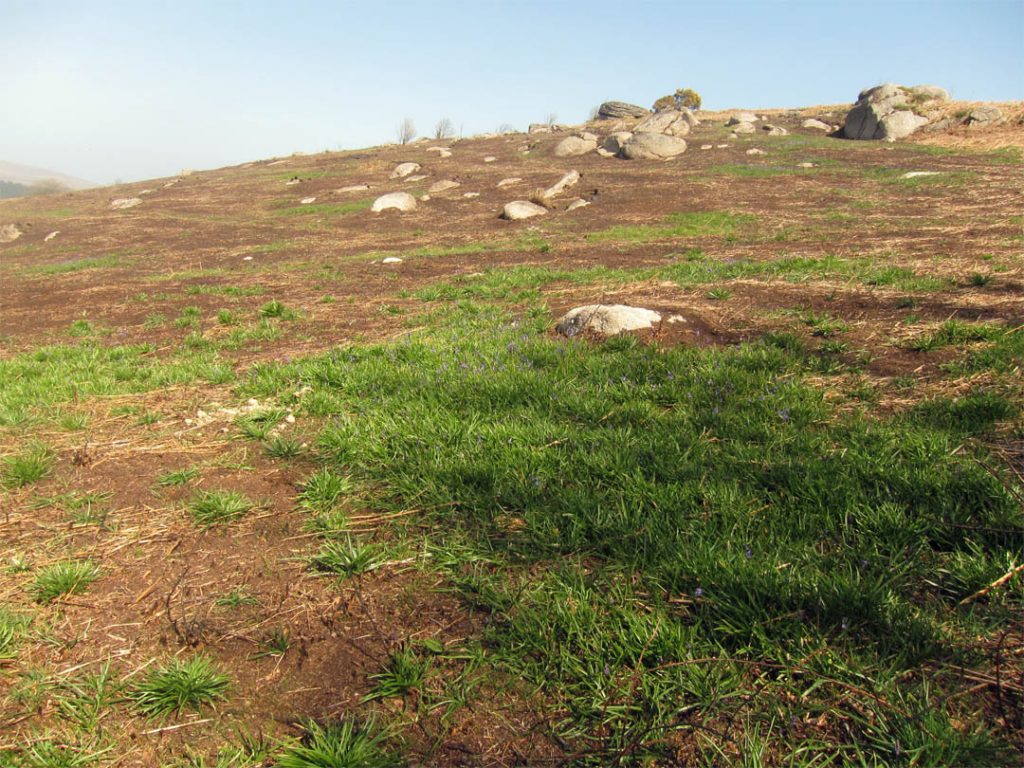Commoners’ rights are attached to properties and therefore traditionally have been enjoyed by the occupiers of those properties.

Commoners maintaining a centuries-old tradition. photo © Chris Chapman
A quick examination of the rights claimed during the registration process starting in 1964 reveals a bewildering mixture, particularly when it comes to who has and who has not pre-sumed rights to turbary and estover. Neither of these rights are exercised today.
Although the link is now tenuous, how many animals you had a right to pasture was tradi-tionally dependent on the size of the property and the amount of stock that a holding could keep on its own land during winter. A property may be a whole farm, an individual field or even a house with a plot of land in Chagford.
Today there are less than fifteen commoners who are active graziers, the remaining two-thirds opting to be “non-graziers”, all party to an agreed management plan made with DE-FRA. (Department for Environment, Food & Rural Affairs)
Learing
To prevent individual flocks and herds roaming across the whole of the open moor, animals are “trained” to remain in a limited area. This is known as a “lear”. Successful learing requires herds or flocks to graze next to one another, so a large area becomes populated by blocks of different herds. Each herd or flock then becomes accustomed and attached to a particular area of ground. For farmers exercising their common rights on the open moor it’s essential to establish a lear so their stock can be easily located and managed.
A properly leared flock of shop will return to their familiar lear on the commons once they have some time down on the farm, for example after shearing. In the rest of the UK learing is generally known as “hefting”. The ancient practice of learing by the commoners is a striking illustration of the enduring connection of both animals and people to place.
Swayling
Swayling is the practice of burning overgrown vegetation – heather, gorse and long grasses – to allow the growth of fresh grasses to improve grazing. It’s a management tool that’s been practiced for hundreds of years, possibly going back to the earliest farmers on Dart-moor. The practice is now subject to strict regulations. Nationally legislation states that burning can only take place between 1st October and 15th April, but on Dartmoor a voluntary code restricts the practice to 31st March, to protect ground nesting birds. Swayling is usually done by groups of commoners and for some the occasion is regarded as a social activity, where neighbours get a chance to meet up. Meldon and Chagford Common are regularly swayled and a large block on the west side of Meldon was swayled in early 2019. By the late spring a mass of bluebells appeared above the burnt ground and now it supports a full cover of vegetation. But swayling has become controversial, especially when it takes place very visibly close to the town. Swayling helps maintain the open landscape that is the familiar picture of the moorlands but it can have an adverse effect on some wildlife.

Management through Higher Level Stewardship
Since the early 2000s grazing and other management activities on the Chagford Commons (as on much of Dartmoor) have been carried out by farmers according to criteria set out in a Higher Level Stewardship (HLS) agreement made with DEFRA. The agreement, arranged through the Chagford Commoners Association, involves working to a management plan that includes: stocking rates (i.e. how many animals are allowed to graze), tasks such as clearing gorse, the timing and location of swayling, and a “shepherding” regulation that specifies where and how many animals can be kept in certain places at particular times.
Winter grazing, except for ponies, is largely not allowed. The overall aim of the plan is to conserve and even restore certain habitats that are deemed valuable ecologically and to avoid the degradation that had occurred previously through less restricted grazing and the over-wintering of stock. To achieve an agreement all those with common rights have to agree to the plan, including the commoners who decide to become “non-graziers”. This leaves the active graziers responsible for carrying out the management plan.
Both the active graziers and the non-graziers are given grants from the Rural Payments Agency. The amounts are set according to a calculation of what income has been foregone by complying with the management plan, which places considerable restrictions on income-generating grazing and adds extra responsibilities on top. Most involved in the scheme feel that the payments are modest in comparison to the amount of extra responsibilities incurred by being party to the HLS scheme. In addition, there is a widely held view that the restriction on stocking rates and more limited swayling has led to the growth of bracken, gorse and, on much of Kestor and Fernworthy commons, domination by purple moor grass (Molinia caerulea).
Climate change and the deposition of aerial-borne nitrogen (originating from vehicle emissions) are also factors at work here. So the HLS management regime, contentious and certainly complicated, is a major part of the on-going debate about what and who Dartmoor is for.


